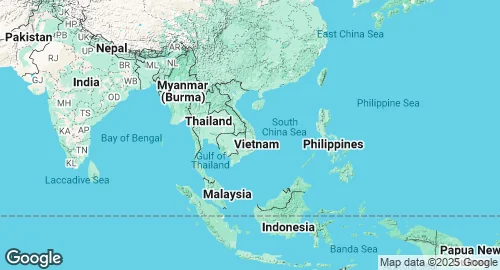Vietnam Military Forces 🇻🇳
Military Strength Overview
| 🛩️ Air Force | 246 active aircraft |
| ⚓️ Naval forces |
112 ships in fleet
– incl. 9 submarines |
| 🪖 Active Troops | 450,000 personnels |
| ⛑️ Reserve Troops | 5,000,000 personnels |
| 👮♀️ Paramilitary | 40,000 personnels |
| 🎖️ Military ranks | 16 ranks listed |
Defense Statistics & Key Metrics
| Population | 99.7 million (2022) |
| GDP | $410.3 billion (2022) |
| GDP per capita | $4116 (2022) |
| Military Budget | $5.5 billion (2018) |
| Share of GDP in Milex | 1.8% (2018) |
| Share of Govt Expenditures | 8.8% (2018) |
| Military spends per capita | $57 (2018) |
| Inflation Rate | 3.16% (2022) |
| Military Personnel | 522,000 (2020) |
Strategic Overview in 2025
The Socialist Republic of Vietnam is a military power in Southeast Asia, shaped by a history of conflict and a pragmatic approach to modern strategic challenges. Its military posture is primarily defensive, focused on safeguarding its sovereignty and maritime interests, particularly in the contested South China Sea.
Military Forces
The Vietnam People's Army (VPA) is a large and capable force, with active personnel estimated to be between 450,000 and 600,000, and a substantial reserve force of around 5 million. The VPA's structure is comprehensive, encompassing ground, naval, and air forces, as well as border and coast guards. A key feature of the VPA is its dual role in national defense and economic development, with military-owned enterprises playing a significant part in the national economy.
Vietnam's ground forces are extensive but face the challenge of aging equipment, largely of Soviet-era origin. However, a concerted modernization effort is underway, with a clear prioritization of the Navy and Air Force. This includes the acquisition of modern assets such as Kilo-class submarines, Gepard-class frigates, and Su-30MK2 fighter jets. There is also a growing emphasis on developing advanced capabilities in cyber and electronic warfare.
Defense Industry and Procurement
Historically, Vietnam has been heavily reliant on Russia for military hardware. While Russia remains a key supplier, there is a clear strategic shift towards diversification of procurement sources. This has been driven by concerns over Western sanctions on Russia and a desire for greater strategic autonomy. Vietnam is increasingly turning to new partners, including the United States, Japan, India, and various European and Middle Eastern nations, for advanced military technology.
In parallel, Vietnam is investing heavily in its domestic defense industry with the goal of achieving greater self-reliance. State-owned enterprises like Viettel are at the forefront of this effort, developing indigenous capabilities in areas such as UAVs, coastal defense missile systems, and radar technology. The government's policy promotes a dual-use approach, where the defense industry contributes to both national security and socio-economic development.
Strategic Trends
Vietnam's military strategy is guided by a "Three No's" policy: no military alliances, no foreign military bases on its territory, and no aligning with one country against another. This policy of strategic independence is complemented by a pragmatic and flexible "bamboo diplomacy," aimed at building a network of international partnerships.
Vietnamese Military Budget History
Population and Military Personnel Trends
GDP and Inflation Rate Trends
Military Expenditure: SIPRI Milex.
